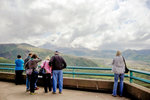

In a weekend that commemorated the 35th anniversary of Mount St. Helens’ violent eruption, May 24 featured a handful of survivors sharing their experiences of narrowly escaping the volcano’s wrath at the National Monument’s Science and Learning Center.
The event started with ceremonial drumming and singing by members of the Cowlitz Indian Tribe. Called Lawetlat'la (which roughly translates into “the smoker”), the mountain played an important role in tribal history, serving as both foraging area and a meeting location with other tribes.
“We came to honor the mountain,” Don Van Mechelen said. “The mountain was a landmark for our people for centuries.”
Carolyn Driedger, U.S. Geological Survey, spoke of the short but powerful life of the young scientist David Johnston, one of the 57 people who were killed in the eruption. Driedger was one of the last people to see Johnston alive. She and a couple other scientists met with him near where he was camping and monitoring the volcano on the weekend of the eruption.
“David stated in a friendly but serious way that if the bulge failed it’d slide up over the ridge and into us,” she told the audience.
He told them the area wasn’t safe and urged them to return to Vancouver.
“(His) skills changed our plan and saved our lives,” she said.
Keith Ronnholm was a graduate student focused on geophysics at the time and watched the north flank collapse and the lateral blast from his truck camper in Bear Meadow, about 10 miles away from the volcano. Before the big blast, it was sending a plume of steam and ash up every few days and he wanted to see it.
“If you’re interested in sciences and the natural world and a volcano is erupting 100 miles away in your backyard … I wanted to see an eruption,” he said.
He was just waking up when the entire north face slid down. By the time he jumped out of his camper and into the truck for his camera, the eruption had started. He watched a cloud of ash come toward him, leaping ridges like waves breaking a levee.
“I realized that’s not slowing it down,” he said.
He snapped photos between gathering his belongings and driving out. Through his windshield he saw a placid spring morning in the mountains, but in his mirrors an unprecedented disaster was unfolding. When the eruption led him into a black cloud of ash, he was unsure if he’d suffocate. He soaked a handkerchief and breathed through it. Unable to see, he eventually stopped in the pitch dark cloud.
“The ash whispered like snowfall. Thinking of Vesuvius and Pompeii, I thought, ‘Six feet I’m dead, six inches I’m OK,’” he said.
Soon, several other vehicles appeared behind him, one of which was a logging truck shepherded by two men on foot who were feeling for the edges of the road.
Ronnholm fell in line and the caravan eventually found its way to Randle, where they cleaned up in a church.
Through the radio he got enough information to learn the cloud was drifting east and he was able to return home.
Joe and Annie Sullivan, their young daughter and her brother Mark Dahl had driven into the forest around the South Fork of the Toutle River where they stopped for a moment. The decision proved lifesaving as at least one other person was killed in the area they originally intended to visit.
They were about 17 miles into the wilderness when the mountain blew.
Joe was a cutter for Weyerhaeuser at the time and knew the area well. He knew that they wouldn’t be able to outrun the eruption. To the protest of his wife and brother-in-law, he changed roads to a shorter route and drove back toward the mountain before turning away again. Their flight took them over bridges that were washed out by debris shortly after. They dropped into the Kalama River drainage and could see the volcano blow and the lightening bolts that shot from the ash cloud. Joe drove while Marc shot photos from the back of the truck.
The Associated Press and other news organizations asked for the photos mintues after they came into Castle Rock, but Dahl declined. He waited a year before developing the photos because he’d heard stories of the film being stolen by the developers. From then on, he’s given them away to anyone who’s asked. He also spoke of how fortunate they were to reroute their morning trip. Looking back, he said it was a day that forever changed their lives.
“It’s like going to Reno and hitting three sevens. We hit the jackpot that day by making it out alive,” Dahl said. “It was the experience of a lifetime.”